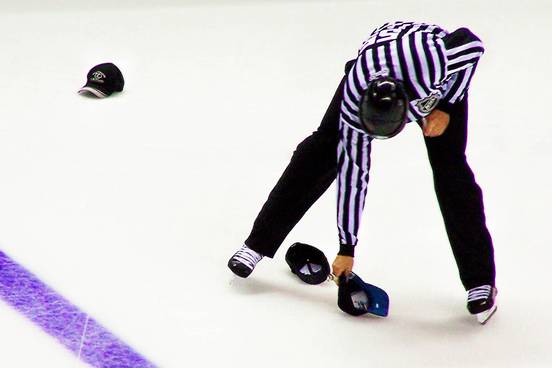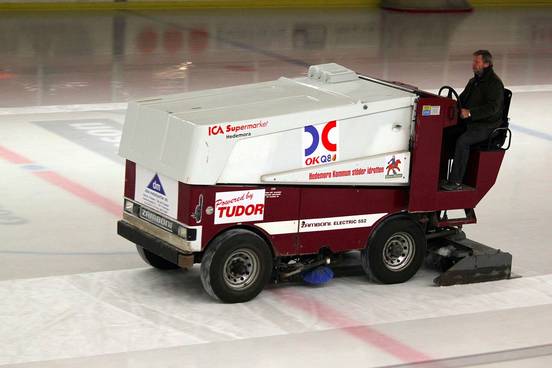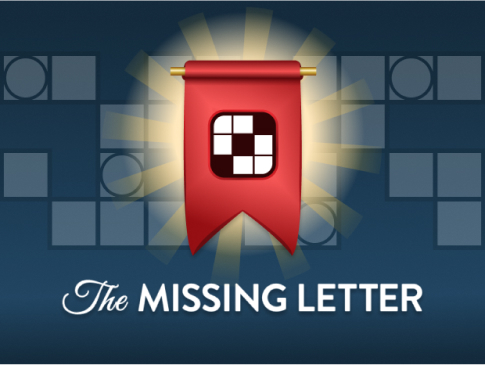
Hockey
If you’re not used to watching it, hockey can be a confusing game: it’s fast-paced, changes direction quickly, and play suddenly seems to stop for no apparent reason. Much like the name for the sport itself, hockey.
The word first appeared in English in the early 1500s, where it was first used obliquely to refer to a sport that seems to be similar to today’s field hockey: “...and also at no tyme to use ne ocupye the horlinge of the litill balls with hockie stickes or staves ... ” (Galway Statues in the Tenth Report of the Royal Commission of Historical Manuscripts, 1527).
And then, hockey (the word) apparently dropped off the map. There’s a reappearance of it in one of William Cowper’s letters from 1785 (“The boys at Olney have likewise a very entertaining sport, which commences annually upon this day. They call it Hockey, and it consists in dashing each other with mud, and the windows also”), but then it comes back into use in the early 1800s to refer to a few different games that involved hitting a small ball or object with a stick.
The earliest use of the word hockey to refer to a game on the ice comes from the Times of London in 1840: “...he saw a number of boys playing hockey bang on the ice at the west end.” Whether this was the game we’re familiar with or another hybrid game, we don’t know, but by the 1860s, the word was in use to refer to a game played on ice using hooked, or the more-familiar crooked, bladed sticks in use today.
Hockey itself is likely an alteration of the earlier French word hoquet, which means “shepherd’s crook,” and which describes the shape of a field hockey stick.
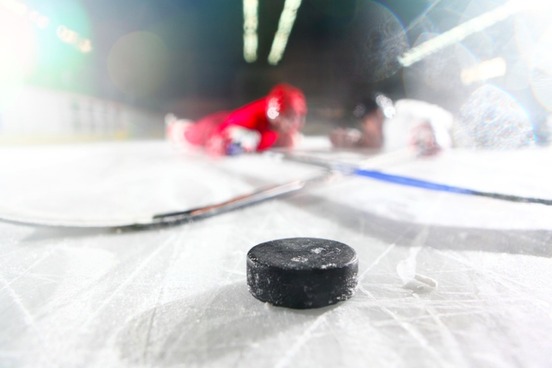
Puck
You can’t have hockey without the puck. That’s the black disk of vulcanized rubber that is one inch high, three inches in diameter, and which is batted around the ice during a hockey game.
The word puck is something of a mystery. Etymologists believe that the word comes ultimately from the Irish word poc, which refers to a stroke in an Irish game called hurling which is similar to field hockey. The Irish word gave rise to an English dialect verb puck, which means “to poke” or “to hit,” and we transferred the name for the action to the thing being hit. How did an Irish word end up describing a piece of equipment in a Canadian game? It may be through Irish settlers in Nova Scotia who were familiar with hurling and got involved in creating ice hockey. (There is another English word puck that refers to a mischievous sprite, but that puck is unrelated to the hockey puck).
The ice hockey puck has gone through a number of changes over the years. The earliest games of ice hockey were played with balls: we know this because an 1875 article in the Montreal Gazette says so: “Hockey is played usually with a ball, but last night, in order that no accident should happen, a flat block of wood was used so that it should slide along the ice without rising, and thus going among the spectators to their discomfort.” The word puck itself supposedly appears in the pages of the Montreal Gazette the following year, though this can’t be substantiated by etymologists.
By the 1880s, rubber was being used in place of wood, but our earliest use for the word implies that the puck wasn’t always round: “In hockey a flat piece of rubber, say four inches long by three wide and about an inch thick, called a ‘puck’, is used” (Boston Daily Globe, 28 Feb. 1886). Some sources claim that round pucks came into use in the 1880s, as rubber balls were cut down and used during play.
There have even been attempts to improve the puck in recent times. In 1996, Fox Sports responded to viewer complaints about the difficulty of seeing the puck on the ice with an “enhancement.” The puck was implanted with infrared sensors that allowed computers to track its whereabouts on the ice and display it on broadcasts as either a blue dot or a red comet, depending on how fast the puck was traveling. Though the pucks were only used in some NHL games, fans absolutely hated them, and some players weren’t too keen on the added weight that the sensors gave to the puck. The glowing puck was phased out of use by the 1998 Stanley Cup season to everyone but Fox Sports’s relief.

Rink
The field of play in hockey is known as a rink: a smooth surface of ice marked off for a hockey game. But rinks predate the game of ice hockey by about half a millennium.
The original rink shows up in Scots English in the late 1300s to refer appropriately to a space that was set aside for battles, combats, or jousts. The Scottish borrowed it from medieval French, where renk or renc referred first to a row of soldiers, then later to a place where jousts happened.
The word rink stayed in Scots English, where it also came to refer to a course that someone could run, and then later to the teams involved in a game of quoits (a game similar to horseshoes) or curling (a game similar to nothing). It developed other meanings, but curling moved rink to the ice, where it eventually came to refer to a space of ice marked off for curling, and then later for any sport or recreation that takes place on the ice. Rink was first used with regard to ice hockey in the 1880s, a few years after the first organized indoor and outdoor hockey games were played: “In the larger villages the ... hockey rink ... should supplant other enervating and pernicious means of amusements” (Vermont Watchman, 13 Feb. 1884).
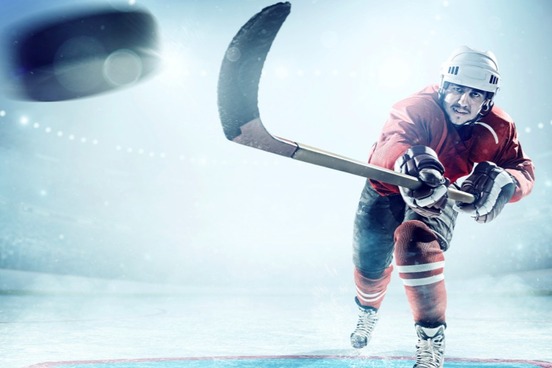
Slap shot
You might think that there’s just one way to hit a puck, but there are four basic shots in ice hockey.
The slap shot is the one familiar to most people—so familiar, in fact, that it lent its name to a 1977 movie about a struggling hockey team that starred Paul Newman and Michael Ontkean. It’s so called because the player taking a slap shot pulls their stick back, away from the puck, and slaps the puck towards the net with significant force. Slap shots tend to happen further away from the crease, or the area in front of the net where there’s generally more room for a shooter to maneuver. Slap shots are nothing to sneeze at—Zdeno Chara of the Boston Bruins currently holds the record for fastest slap shot in the NHL at 108.8 mph.
Closer in to the net you’ll often see the wrist shot. The wrist shot, or wrister for short, gets its name from the rotation of the shooter’s wrists as they flick the puck toward the net. It’s a good shot for tight quarters; Joe Sakic, who spent most of his NHL career with the Colorado Avalanche, was renowned for his wrister.
The snap shot is somewhere between a slap shot and a wrist shot. The shooter pulls their stick back, as they would in the wind-up for a slap shot, but the key difference is that the puck remains on the blade of the hockey stick during the preparation for a snap shot. The shooter rolls their wrists as in a wrist shot, and then snaps the stick forward to complete the shot.
The last shot, and one that can be difficult to control, is the backhand, or backhander. Most shots in hockey are forward: that is, the palm of the dominant shooting hand is facing the goal. Backhand shots are ones taken when the palm of the dominant shooting hand is facing away from the goal, and the back of the hand is facing the goal.
Backhanders can be difficult in hockey because the blades of most hockey sticks have a noticeable curve towards the forward shot to help corral and control the puck. In a backhanded shot, the shooter moves the puck to the back of the stick, where the curve is convex and not concave.
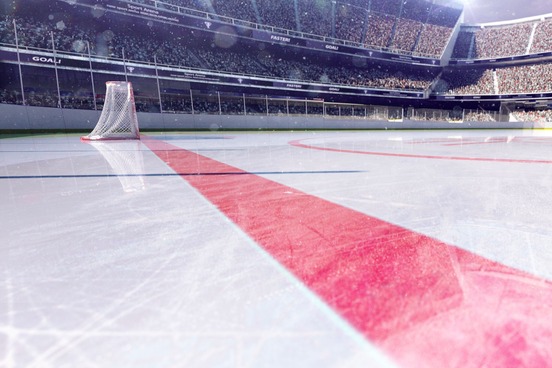
Icing
Most hockey penalties are pretty self-explanatory: slashing, high-sticking, roughing. But there’s one that even the most ardent fans have a hard time explaining: icing.
The ice is divided into three zones: the neutral zone, which is the center of the ice; and each team’s defensive zone, where offensive players try to score and defensive players (also called d-men) try to keep them from scoring. If you watch a hockey game, you’ll notice that there’s a thin red line at the mouth of each goal: this is the goal line, and it’s used to judge goals and icing penalties.
Though there are variations on what icing is, the most basic explanation for it is this: icing is when a player who is behind the center-ice line shoots the puck across the center ice line, the defensive zone blue line, and past the goal line without the puck ending up in the net or being touched by the defending goalie. Icing can be waved off (canceled) at the discretion of an official, and if a team that is shorthanded ices the puck, or the puck is iced immediately after a face-off, the penalty is always waved off.
One reason why icing can be a confusing penalty is because the NHL’s rules on icing have changed over the years. For many years, the NHL used touch icing to determine whether to call a penalty: essentially, if the puck is touched by the defending goaltender or a player on the attacking team, then the penalty is waved off and play continues. This led to a lot of high-speed collisions at the boards, leading to injuries. The NHL now uses something called hybrid icing: play is stopped if an opposing player chasing the puck reaches the face-off dot.
What a weird rule: but it came into existence as a reaction against a common stalling tactic teams used to keep their lead. In a 1931 game between the New York Americans and the Boston Bruins, the Americans tried to preserve their one-goal lead by icing the puck over 50 times. The crowd was incensed and threw things onto the ice to stop play; in a rematch between the teams a few weeks later, the Bruins retaliated by icing the puck 87 times. That later game ended in a scoreless draw. The rule prohibiting icing the puck came into effect in 1937.
The verb ice first appeared in print in 1933 to describe this act of moving the puck across the ice; the noun icing didn’t appear in print until 1938, shortly after the NHL adopted the icing penalty.
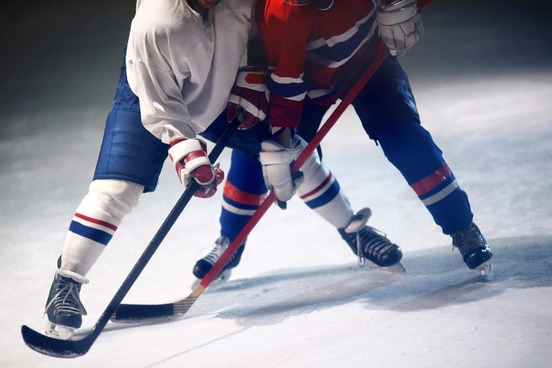
Slew-foot
There’s another type of penalty that doesn’t get called often, but which inspires a significant amount of discussion by fans, and that’s the slew-foot.
Generally speaking, a slew-foot is when a player comes up behind or alongside an opponent and uses their foot to knock the legs out from under their opponent. In some leagues, a slew-foot also needs to include a backward shove to the upper body; in others, it’s just a trip from behind. Fans will hotly debate whether a tripping penalty was really a slew-foot, and whether a slew-foot that doesn’t result in a violent backward fall should be a match penalty.
But ignore the actual penalty for a moment, and ponder: slew-foot? The name for the penalty was taken from an earlier noun, slew-foot, which refers to a person who walks with their feet turned out. The earliest use we have for the word comes from the American South in the 1870s, where court documents refer to “slewfoot” tracks made by someone whose “right foot was slewed, or twisted out” (McAlpine v. State of Alabama, January 1872). The word gained use in songs and fiction, and eventually came to refer to a clumsy person as well.
The slew in slew-foot is something of a mystery. It first showed up in the 1700s, spelled slue, in nautical contexts to refer to turning something around its axis, as in “slue the mast ‘round.” It was taken into more general contexts to refer to turning, but etymologists have no clear idea where the verb slew came from in the first place.
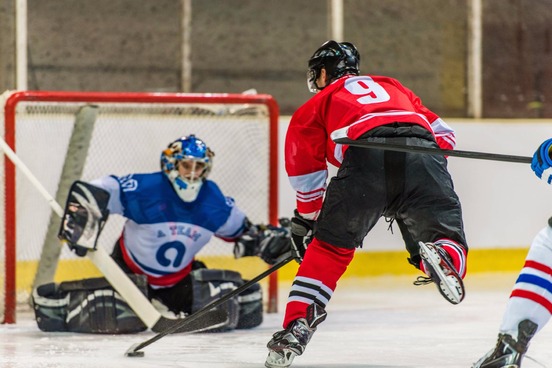
Deke
Hockey is full of shortened forms of words: a great goal is a beaut, the defenders are d-men, and a good feint is a deke.
We can trace the hockey deke back to a specific player: Dickie Moore, who played for the Montreal Canadiens from 1951–1963. He was a left wing known for his hard shot, the finesse with which he handled the puck, and his ability to fake out goalies.
In 1960, Time Magazine interviewed Dickie Moore and asked him about his fake-out skills:
I've developed a little play of my own... It's a kind of fake shot—we call them “deeks” for decoys. Sometimes the goalie gives you an opening deliberately and then breaks your heart by blocking the shot. I pretend I'm taking the opening by flicking my stick over the top of the puck. The goalie moves, and then I either flick it between his legs or into the other side.
This wasn’t the first instance of deke in print, however: Hemingway used the noun deke to refer to duck decoys in his novel Across the River and into the Trees in 1950, a decade before Moore called his fake-outs deeks. In a twist, Hemingway’s use fell to the wayside, and Moore’s rose. The noun came to be spelled deke (perhaps influenced by a nickname that was common at the time: Deke), and in 1961, the verb deke came into use as well. Though deke has been lent to other sports, such as basketball and baseball, it’s still associated most strongly with hockey.
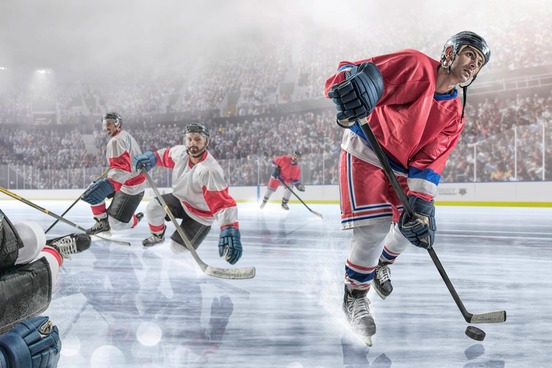
Dangle
A deke isn’t the only feint in hockey: there’s also the dangle.
Dangling is generally understood in hockey to refer to maintaining possession of the puck through any number of opponents and shooting on goal using deft stickhandling, and sometimes with a deke or two. Good dangles are a thing of beauty: pucks threaded between opponents skates, puck-carriers dekeing with quick changes in direction or a spin-o-rama, a shot tucked neatly into an open net as a goalie lunges in one direction and the shooter takes the puck in another. A good dangle requires skill and finesse.
The hockey dangle (both noun and verb) likely came into being from an extended use of the existing verb dangle, which means “to hold out as an inducement”:
When the puck carrier makes the play and attempts to get around the defense man, the protecting player must concentrate on getting the turn and drive, making only a secondary use of the stick. For example, the stickhandle by the puck carrier may dangle the puck out as bait. The defense man bites by making a jab at the puck. Then the attacking player pulls the puck back out of the way, dodges, and carries by into the clear of the scoring zone.
—Richard F. Vaughn, Hockey, 1939
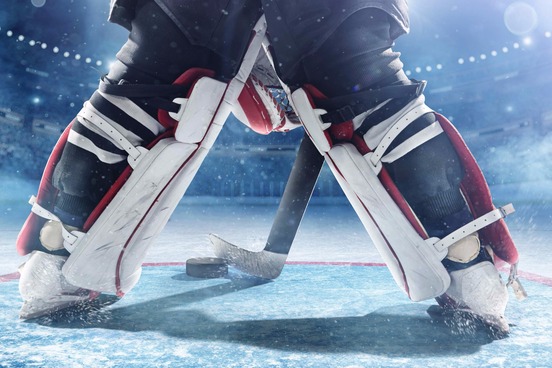
Five-Hole
Goalies have the hardest job of any player on the ice. They must block any and all shots that come their way, regardless of the velocity of the shot or the proximity of the player making the shot. This means they regularly get hit with 100-mph pucks, get stepped on, get crashed into, and literally throw themselves right into the fray when a puck is loose in front of the net. They also have to rely on feats of contortionism to do their job well.
When a player shoots the puck low, goalies will sometimes defend the goal by dropping into the butterfly: a stance where their feet are out and their knees are locked together. The position gets its name because the goalie’s rectangular pads are angled out like the wings of a butterfly.
But a sloppy butterfly can lead to a goal right through the five-hole; that is, the gap between a goalie’s legs. The concept of the five-hole likely originated with Jacques Plante, NHL goalie and author of the 1972 book On Goaltending. Plante numbered five “holes” in the net that goalies needed to protect: four at the corners of the net, and the hole between the goalie’s legs. Though there is some debate about how to number holes one through four—Plante lists one through four as stick-side low, glove-side low, glove-side high, and stick-side high—all sources follow Plante’s lead when it comes to the five-hole. Though no one uses one-, two-, three-, or four-hole when referring to shots or saves, five-hole has stuck for shorthand for “between the legs.”
Plante didn’t just give the hockey world the word five-hole: he also popularized the goalie mask.
Though it’s not appropriate to throw things from the spectator’s area onto the ice during play (unless you are a Red Wings fan), there is one time when it is not only okay, but expected: following a hat trick.
A hat trick is when one player scores three goals in one game. Since hockey tends to be a low-scoring game, unlike basketball, three goals in one game is a big deal. Tradition dictates that when a player scores a hattie, as hat tricks are informally called, fans throw their hats onto the ice. But why?
The hat trick originated not with hockey, but with cricket. In cricket, a hat trick is when a bowler gets three consecutive wickets (or outs) in three consecutive balls. They are very rare—so rare, in fact, that back in the mid-1800s this feat entitled the bowler to a prize from his club, and that prize was usually a hat.
Within about 25 years, hat trick had moved beyond cricket. The National Hockey League claims that in the 1930s, a haberdasher in Toronto promised to give one of his hats to any player who scored three goals during an NHL game played in Toronto, and some claim this is the origin of the hockey-related hat trick. But the line of derivation is pretty clear—hockey fans have cricketers to thank for the hat trick.
There is one hat trick that only hockey can lay claim to, however, and that is the Gordie Howe hat trick, in which a player scores one goal, tallies one assist, and gets in one fight in one game. This hat trick is named for Gordie “Mr. Hockey” Howe, who spent most of his NHL career with the Detroit Red Wings, and is the only hockey player to have played pro hockey in six consecutive decades: 1946–1971 with the Red Wings; 1973–1979 with the Houston Aeros and the New England Whalers (both in the WHA); 1979—1980 with the Hartford Whalers (NHL); and 1998 for one shift in one game with the Detroit Vipers (IHL). Though Howe is a Hockey Hall of Famer, it’s not as though he made a name for himself with his particular take on the hat trick: he only got a Gordie Howe hat trick three (possibly four) times in his career.
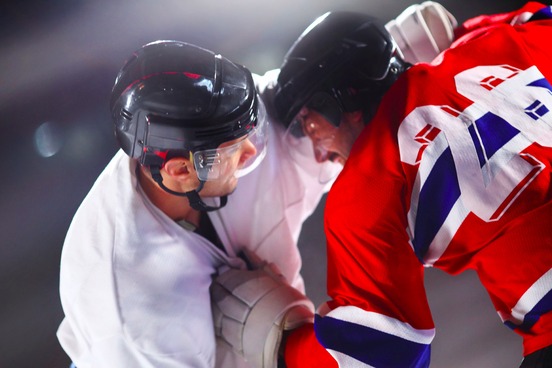
Dance
There’s a point in almost every NHL game when two players pull themselves away from the action in order to dance. It’s not ballroom: it’s a fight.
Fighting in ice hockey is a tradition, and one around which there’s been a lot of discussion and disagreement in recent years. Some regard it as an indispensable part of the game, a way to punish players who make dirty hits or go after a team’s star players; others contend that it has no place in the modern hockey game, as good officiating should take care of dirty hits, and fights merely create injuries (particularly concussions). Regardless of how you feel about it, an entire vocabulary has built up around fights on the ice.
There are players whose primary job on-ice is to deter or respond to dirty hits or plays by the opponent. They’re called enforcers, though if there’s an enforcer who’s roughing up the players on your team, you might call them a goon instead.
When an enforcer feels the need to start something (instigate a fight) with another player, they might get chippy or ask the player if they want to go (fight). If the player does indeed want to go and a fight breaks out, commentators will say that they’ve dropped the mitts or dropped the gloves (taken off their gloves, also called mitts, in preparation for a fight), or that an instigator has asked the player to dance. Once the actual pummeling begins, the fight is sometimes called a donnybrook, a dustup, or fisticuffs. After the refs have broken up the fight, one or both of the players might be given a penalty and sent to the box, also affectionately known as the sin bin.
If you’ve ever been to a hockey game as opposed to having just watched one on TV, you know that the intermission between periods is full of activity. Some clubs feature mini-matches between their youth leagues; some feature slap shot contests for game-goers; some feature mascot craziness. But all of them have one thing in common: the Zamboni.
A Zamboni is an ice-resurfacing machine. Every turn, pivot, stop, and rush down- or up-ice creates divots and ridges in the playing surface, and while most players can handle some choppy ice, certain spots in the ice get more abuse than others (the crease is one example). Uneven ice can lead to unintentional falls, which can, at worst, lead to injury. Enter the Zamboni.
It looks a little like a street-sweeping machine wrapped in sponsor ads, and its job is to mechanically smooth out the ice surface. Prior to the creation of the Zamboni in 1949, ice rinks had to be resurfaced by hand. That meant that a blade was pulled across the ice, usually by a tractor, to level the ice. Three or four people would scrape the shavings off the ice, and then spray the scraped surface with water. They’d squeegee the dirty water off the surface, then put clean water down to refreeze. The process could take up to an hour.
In 1942, Frank Zamboni began to experiment with ways to mechanically resurface the ice, and by the summer of 1949, his Model A Zamboni Ice Resurfacer was completed. The Zamboni, as it was later called, became an abiding presence at hockey games.
Zamboni is capitalized because it is a trademark, though the vast majority of the public calls all ice resurfacers Zambonis, regardless of what brand they are.
